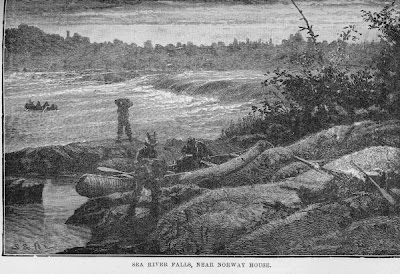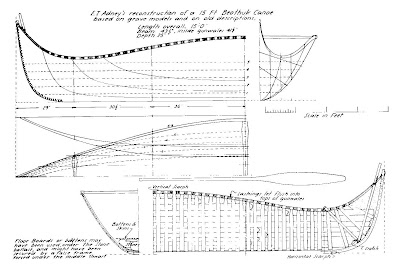Hokule'a is without a doubt the most famous Hawaiian double canoe in existence. After a rough start beset by political and personal conflicts that nearly wrecked the project, she has gone on to complete many impressive voyages, the last one in 2007. Owned by the
Polynesian Voyaging Society (PVS), she serves as an icon of native Hawaiin culture and a training platform for teaching traditional navigation and seamanship.
Hokule'a had her start around 1973, when Ben R. Finney, an anthropologist with an interest in the settlement of the Pacific islands, decided to scale up from a smaller, self-funded double canoe on which he had begun his investigations of the type. As described in his book
Hokule'a: The Way to Tahiti
, his original motivation was primarily scientific: to test whether the double canoe type had sufficient windward sailing capability to have made feasible the intentional colonization of the Pacific from west to east. This was in contrast to countervailing views that the colonization was either unintentional -- a result of unplanned drift voyages by castaways -- or that it had occurred from east to west, starting from the South American continent. (This latter theory was promoted by Thor Heyerdahl.)

Finney and his early partners founded the Polynesian Voyaging Society to help organize and fund the project but, according to Finney, the organization and the project were hijacked by nativist Hawaiians who wanted to use the canoe to promote Hawaiian cultural identity. Finney felt that the two objectives were almost entirely incompatible, and his book concentrates mostly on the resulting conflicts. (He acknowledges, however, that his narrative is quite one-sided.) The book is a tale of a terribly-managed project that just barely managed to fulfill its original goals in the face of tremendous personnel problems. Along with insubordination, there were fistfights and threats of mutiny.
Somehow, the Polynesian Voyaging Society turned the situation around later, and Hokule'a has clocked more than 32,000 sea miles on a half a dozen voyages, visiting most areas of the Pacific, mostly on cultural missions. (A circumnavigation is apparently in the planning stages!) Finney's name is hard to find in any context on the PVS website: he doesn't appear to be currently associated with the PVS, and it wouldn't surprise me if he dropped out immediately following the first awful voyage and has been placed under a taboo by the organization. PVS seems to be almost exclusively concerned with using the boat as a way to champion cultural identify -- there is very little about serious science on their website.
(In addition to the PVS website, much information on
Hokule'a may be found on
Wikipedia, although the article appears to hew closely to the PVS orthodoxy and gives little credit to Finney.)
The boat itself is unusual and impressive. The PVS calls her a "performance-accurate" replica, meaning that she is believed to perform like the traditional boats she resembles. Construction-wise, however, she's quite different. The hulls are cold-molded, with several intermediate bulkheads, rather than carved from single huge trunks. (PVS has subsequently built another canoe,
Hawai'iloa, from huge Alaskan cedars -- about as close to the original construction as is possible at this time, since Hawaiian
koa logs of the necessary size are no longer obtainable.) Steering is done with steering oars, which do not pivot side to side; direction is controlled by simply lowering the oars into the water or raising them out of it. With an LOA of 62'4" and beam of 17'6", she is much narrower than a modern catamaran of the same length but in keeping with the traditional configuration, which was narrow "due primarily to the limited ability of the wooden cross-pieces and coconut fiber lashing to withstand the phenomenal stress the ocean imposes on a widetrack double-hull craft," according to Tommy Holmes in
The Hawaiian Canoe
.
Her original rig was a very modest 540 square feet of sail area on two crab-claw (spritsail) masts, which gives her performance on the order of 3 or 4 knots upwind, and 5 or 6 downwind . She is capable of tacking to within 70 or 75 degrees of the wind -- comparable to the pointing ability of square-rigged ships -- which, based on the results of the first voyage, from Hawaii to Tahiti, was sufficient to have allowed double canoes to have indeed colonized Polynesia in an intentional effort of exploration and settlement.
(All images in this article from
PVS website.)























